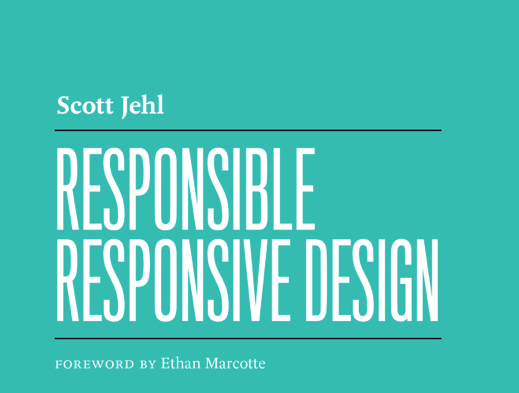It’s been 4 years since Ethan Marcotte’s seminal A List Apart article, and by now, responsive web design has become a pleonasm. All proper web design is now responsive, and the question is no longer if we do responsive, it is how we do it and why we should do it better or more responsible.
In the past few years, responsive web design has matured from the conceptual idea it once was. It influenced thinking about plenty related, general web design issues. Many have written about the role of structured content, web design software and progressive enhancement. As a front-end developer, I know this was also true for the code side of things. We started putting more thought into how content is delivered (first!), have been finding out which kind of client side detection mechanisms work (and which don’t) and tried to come up with solutions for browser testing.
 ! The turquoise cover of ‘Responsible Responsive Design’, published by A Book Apart
! The turquoise cover of ‘Responsible Responsive Design’, published by A Book Apart
Sound reasoning and well-explained code examples#heading-1
So what about the book? I was excited for it to be released, being a fan of all the awesome articles and scripts Scott and the Filament Group have been releasing recently. When the book came out, it was an instant buy, I started reading the same evening.
The most important facets of better responsive websites, according to Scott, are usability, accessibility, sustainability and performance. All four are described in detail in his book, with solid reasoning and handy code suggestions.
‘Responsible Responsive Design’ is a very practical overview of discussions that happened in the past few years, and hands the reader sensible argumentation as per why some responsive strategies are preferable to others. “Finding” breakpoints vs defining them, progressive enhancement vs graceful degradation, ‘web-safe’ gestures vs false assumptions, feature detection vs browser sniffing, FOUT vs FOIT and much more. If technical arguments don’t convince, he also shows examples of big websites that use solutions like Picturefill (Microsoft), responsive source order scripts (The Boston Globe) and Shoestring (Lego).
Secondly, other than explaining why some things are sensible solutions, Scott also explains how to do things with code examples, and walks the reader through the workings of some of the techniques he discusses, like the sizes attribute, cutting the mustard and loadCSS().
Responsible decision making#heading-2
I found it very useful to read what Scott had to say about why we should do responsive design responsibly. Some benefits of the ‘responsible’ techniques are quite technical in nature, making them difficult to argue for. But they impact people everywhere. Arguing for those people is an important part of being a responsible responsive designer. Things like prioritising loading content over loading the fancy fonts, can be difficult to explain, and Scotts book makes this easier. It is easier to convince management to go for a cutting the mustard type of approach, if you can say that big organisations like the BBC and the Boston Globe do it, too.
Anyway, I can highly recommend ‘Responsible Responsive Design’. If you ever design or build websites, and are unsure whether your responsive strategies are indeed responsible, read this book!
How to get the book#heading-3
‘Responsible Responsive Design’ is available from A Book Apart.
Comments, likes & shares
No webmentions about this post yet! (Or I've broken my implementation)